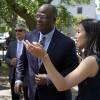In December 2012, the country was reeling. Adam Lanza, of Newtown, Connecticut, had opened fire in Sandy Hook Elementary School, killing 20 children and six adults before taking his own life. He had shot and killed his mother earlier in the day.
Activists responded to the news by starting a White House petition demanding more gun control. President Obama hinted at tougher laws at the Sandy Hook prayer vigil, saying “I will use whatever power this office holds to engage my fellow citizens … in an effort aimed at preventing more tragedies like this.” Poll results made it seem like Americans were ready for change.
And while some gun-control changes were made in the years since Sandy Hook, many activists would argue they weren’t enough. In the months following the shooting, the U.S. Senate defeated several proposals to ban assault weapons and expand background checks for gun buyers. Americans would see many more mass shootings over the next six years.
So why hasn’t the gun reform movement been more effective? And, for that matter, what makes any social movement effective?
Leslie Crutchfield, the executive director of Georgetown University’s Global Social Enterprise Initiative, argues that Second Amendment activists have had a more powerful, broad-based voice than reformists, due to their ability to manage strategy amongst their members.
“At that point in time [after the Sandy Hook shooting], there are two numbers that stand out to me: 5 million and 400,000,” Crutchfield said. “By 2012, the [National Rifle Association] had grown its membership to around 5 million. Whereas the largest reform group — at that time it was the Brady Campaign [to Prevent Gun Violence] — its membership hovered around 400,000. So for several decades, the gun reform movement was one-tenth the size of the gun rights movement.”
Crutchfield says the NRA’s commitment to local membership helped it consolidate such staggering numbers. She says that any social movement that wants to be successful should turn its grassroots “gold.”
One way to do that is to tailor your mission to each individual state. That’s what gay rights advocates did in 2005.
“At the time, marriage equality did not look inevitable. It looked impossible,” Crutchfield said. “So leaders got together and they said, 'What can we try and accomplish?' They started to look at the country, not as this monolithic federation of 50 states, but [instead] they developed what we call a 10/10/10/20 equals 50 lens.”
Instead of advocating gay marriage everywhere at the same time, they focused on manageable goals: Push for 10 states to accept gay marriage in the liberal northeast. In another 10 states, focus on civil unions. And then in 10 more, focus on relationship recognition laws. In the remaining 20 states, simply push for a rollback of discriminatory laws.
“You could get communities across the U.S. to take incremental steps forward towards greater tolerance — maybe not embracing full marriage because that was really a big leap for most people. [It got advocates] saying, 'What can we get done at each state and local level?’ Then they started getting more momentum.”
A decade later, the U.S. Supreme Court ruled against gay marriage bans.
But there are some issues that legislation just can’t fix. Crutchfield points toward the #MeToo movement, which she says requires more of a change in societal norms than an addition of laws on the books.
But Crutchfield says changing culture is possible. Mothers Against Drunk Driving (MADD) did it by making the words “designated driver” part of our vernacular. And the group accomplished that through a successful grassroots movement.
“There's no policy or law that says you have to have a designated driver. But MADD tried to both enforce existing laws and put forth a campaign around [the phrase], ‘Friends don't let friends drive drunk.’ The chapters had the local presence to make that go viral, decades before we had internet. And it became the norm."





